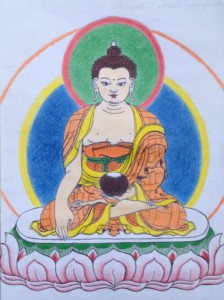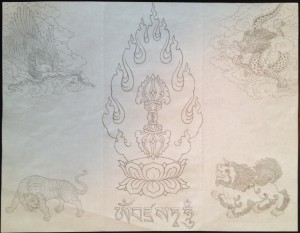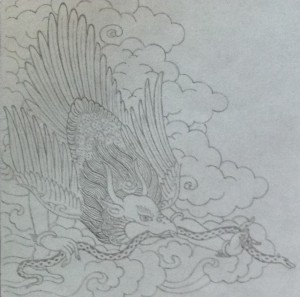Thursday
Featured StoriesFinding Freedom Inside
Being with Jampa Pawo
by Norma Harris
Last year Atlanta Shambhala received an email from Les Ste. Marie at Gampo Abbey. He was passing on a request from a man on death row in Georgia who had been meditating and studying Buddhism. His wish was to receive refuge and bodhisattva vows. On October 3, 2014, I brought Acharya Richard John to visit him and fulfill his wish.
I have continued to visit this man, once each week. We also write and talk by phone. I have gotten to know him well, and have written about him once before. I am advised not to disclose his birth name or give any details about his crime, a brutal murder. But I can let you know something about him and his practice. Jampa Pawo (Kindness Warrior) is the bodhisattva name he was given and with which he has begun to sign dharma writings and drawings, so I’ll refer to him using this name.
Jampa Pawo committed a murder when he was 19 years old. He has been incarcerated for eighteen years and has lived in solitary confinement on death row for seventeen of those years. He has changed, as do we all, even those of us who have done the most horrific of things. We commonly hear stories of people “finding Jesus” when they are facing the death penalty. And this does not preclude the truth that people really do find Jesus – or, in this case, Buddha. Here is a summary of how that happened for Jampo Pawo.
The first things that Jampa Pawo found in prison were shelter and food, basics that were absent from his life as a teenager who had found himself homeless and without hope. He was immediately drawn to art books that he could get from the prison library. He began to draw the art he saw. He also began to notice the themes depicted in great art, so he started to read about these subjects, including history, mythology, psychology and religion. He saw connection in these broad themes, and this caused him to consider that life held meaning. He stopped using drugs and alcohol (that’s right!), and he began making use of his mind. He discovered that he was an intelligent person and a skillful artist.
It was not enough. Though he made a 180 degree change, that change was not sufficient for him to start considering life to be worthwhile; not his life. The change could not erase having committed a murder and having to live with that. How could these skills and attributes ever contribute to him living a worthy life? This question led him into deep depression.
It was then that he began to notice the word Buddhism. It seemed to show up in things that he read or heard. He had read about many religions, but he didn’t know much about this one. He asked his pen pal from England to send him a book about Buddhism. He says that he understood this dharma book immediately. He asked her to send him more.
Even after reading books on the subject, Jampa Pawo saw that to follow this path he would need help. He prayed that he would find people who knew dharma, that they would find him. And people did find him, including Ani Pema Chodron and Thich Nhat Hanh, both of whom corresponded with him, sending books and practice instructions. His connections with Gampo Abbey deepened when Les Ste. Marie and Louise Collin began to correspond with Jampa regularly, and the same occurred with Olivier Sylvere from the Prison Liberation Project in France, who also sent courses on CD.
He became more and more knowledgeable about Buddhism. And with help from faraway others, he trained himself to practice meditation. But he knew that his view was superficial. He needed a way to deepen – a path, a lineage. He was receiving support from others but he was still quite alone. He was a quiet person, someone who spoke little and who had always looked inward. He wanted to be able to put a path together, but he didn’t know enough. He began to have dreams. In one dream he approached a lama that he recognized as the author of one of the books he had been reading. The lama ignored him, and so did the lama’s entourage. He then dreamed of a lama who approached him. Jampa asked him how he could deepen his practice. The lama showed him how to make prostrations. Sometime later Jampa saw a picture of a Lama Zopa and he recognized this as the lama who helped him in his dream. He made a decision to become a student in this Tibetan Buddhist tradition.
After four years of practice and study, Jampa Pawo prayed that he would somehow be able to take formal vows. Atlanta Shambhala was able to make this wish come true, and it is through this connection that he has begun to learn more about Shambhala Buddhist teachings. He was familiar with Chogyam Trungpa, and had read Shambhala: Sacred path of the Warrior. He was also familiar with Shambhala teachings through the writings of Ani Pema. After taking vows with Richard John, he read Ruling Your World, and began to take note of Tibetan and Bon iconography. He was particularly taken with the energies of the Four Dignities, and with ground lungta.
Jampa Pawo essentially lives the life of a monk. His cell is 5x7x9. He is vegetarian. He does formal practice in the mornings and evenings. He reads, draws and writes letters and poetry in the time between. He gets one hour of yard time a day. He lives a life of study and practice.
Jampa Pawo has a beaming presence that radiates strong, cheerful, loving energy. Although he lives with intense physical and emotional pain, he is healthy and animated. He has his priorities, and they always begin with “you” – and end with practice. “How are you? How is s/he or they? Please give him my love. I am sending them a drawing. I have written a poem for her. Can I lead us in this practice? Will you teach me to raise windhorse? Here’s a story about Asanga and Maitreya about that. Please give these books to the Shambhala Library. (You can read them first.) Here is a drawing to help you with your practice.”
I have learned that Jampa Pawo is regarded as a positive force in a place that does not have a lot of positive influences. He does not talk about himself, but pastors who talk with guards and prisoners have told me this about him. When I asked him directly if he felt himself to be “Kindness Warrior,” he seemed at a loss. He finally articulated his view this way: “I try to practice kindness to others. I try to refrain from acting out of klesha energy. I used to be very withdrawn. I would not interact with anyone; I would draw, read and write, and stay by myself. Now I try to offer what I can give. I can offer conversation of a spiritual nature. When people are upset, you can be there to listen to someone. You can advise people to ‘let it go.’ Also, I try to motivate people to be creative.”
As for us, my prison visits are pastoral visits, and this means that we can be in the same room without the need to talk on a phone while separated by plexiglass. We give each other a big hug when I enter, and we touch our foreheads. We sit facing each other in a long narrow room that we sometimes have to ourselves, and that sometimes includes many other prisoners speaking with their ministers or with their lawyers. To us it doesn’t matter. We create our space. We bow and then we move closer to be knee-to-knee. We spend a brief time doing shamatha. We do ground lungta practice because he read about this in Ruling Your World and requested it. We have two hours for this visit. He leads us in short Vajrasattva practice (20 minutes), depending on his need for more talk or more practice. Jampa’s energy is palpable even when we talk about practice. And when we engage in practice, I can feel his energy radiate through me. It is undeniable.
We talk about death, and the practices that will be of benefit if and when he receives lethal injection. He will be practicing the powa described by Sogyal Rinpoche in the Tibetan Book of Living and Dying. He will be doing tonglen, and he will be reciting the Vajrasattva mantra. We practice walking meditation when we have the space. We practice dignity in the face of fear.
We talk up until the very end of our time together. We hear the 10 minute announcement, and we continue to talk even as we walk to the gated door, and even after our hug good-bye. We talk even after I have gone through the door, and even if the officer gives a reprimanding reminder that the visit is over. Sometimes I watch them readying him to go back to his cell. Chaining his hands behind his back. Walking at his side, going from one iron-barred passageway to the next. Disappearing into a world I really cannot imagine, though I ask him endless questions about it, which he answers in patient detail. Often now, he leaves packages for me with books or art to send to others, packages that I sign for on my way out. Often, when I get into my car to drive away, I realize that we have forgotten to dedicate the merit.
Jampa and I have a request, which is that you include Jampa Pawo in your tonglen practice. I do not know when exactly his execution will be, perhaps not until November. He will be granted a clemency hearing the day before his execution date, and if you wish to be informed about that, please email me and I will let you know. Your prayers will be most helpful at that time and then again at the time of the actual execution, should it come to that.
I wish to dedicate the merit of this dharma relationship to all those who have done tremendous harm, those who I think I am so much better than. I give thanks for this teaching on change/ impermanence. I give thanks to the power of bodhichitta.








Nov 13, 2015
Reply
Thank you, Norma, for providing such meaningful support for this practitioner in such a lonely place. I will hold him in my practice and please let me know the dates you mention.
Nov 13, 2015
Reply
Lama Zopa (Patience) — a wonderful name for a lama for a convicted murderer!
Nov 13, 2015
Reply
Dear Suzanne and Trime, Thank you for your heart practices for Jampa. Trime, I did receive your email. Suzanne, please send me yours so that I let can you know of Jampa’s circumstances if this is something that you want. I wasn’t sure.
Nov 13, 2015
Reply
I am so moved – & inspired – by your story and this man’s life. Please let me know further info. He is included in my practice.
Nov 13, 2015
Reply
Of course Jampa Pawo, Kindness Warrior, is in my practice. His story, like the great buddhist tales of penetrating transformation, like the story of my own son Ishmael Beah, is testament to the power of accesing basic goodness, and the possibility of changing repairing- the world – through undiluted compassion and patience.. trust in each other and skillfull means. It is tremendously sad that Jampa is not released to become a great teacher and activist working to help myriads of young people whose early lives were marked with unbearable suffering and lack of love. thank you very much. I am sending your article to Ishmael and going to ask him to write to Jampa.
Laura
Nov 12, 2015
Reply
Norma, thank you for sharing this deeply touching story. I will include Jampa Pawo in my tonglen practice and would like to be kept informed of any developments. I will e-mail you separately with my contact info.
Nov 12, 2015
Reply
Norma
Thank you for this moving share and for all you do. Please allow me the information of impending dates as I hold Jampa Pawo in my practice. And let me know if there is more I could do.
In The Dharma